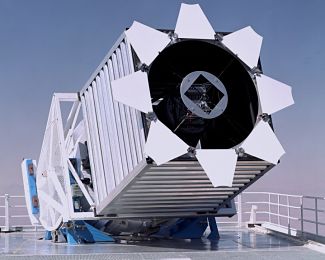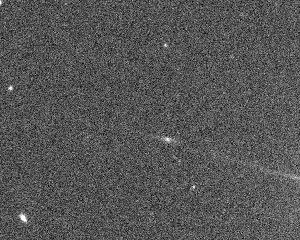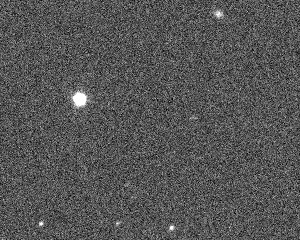Asteroids in SDSS archive
When I started hunt for asteroids in the SkyMorph/NEAT archive in 2006, I had no idea how long I would enjoy this activity, how long would it make sense and what I could achieve. My searching activity was highest in 2009 when I found 46 new, previously unknown asteroids on archive images. The following year I learned about another on-line image archive Sloan Digital Sky Survey (SDSS). At first I used it to extend observation arcs for my NEAT discoveries.
Searching for precovery positions in the SDSS archive
The Sloan Digital Sky Survey (SDSS) program was conducted at the Apache Point Observatory in New Mexico in period of 2000-2008. There was used a 2.5 m mirror telescope for observations. The sky was scanned in five broadband filters (u, g, r, i, z). The CCD camera contains 30 CCD chips, each 2048x2048 px. The telescope is on an azimuthal mount and it is still during observation session, the area of the sky is scanned as it moves across the field of view. Depending on the filter used, limited magnitude of captured objects was from 21.3 to 22.2 magnitude. The survey was primarily designed for supernova research, but obtained CCD images were also applicable for astrometric positions of asteroids. Although almost two decades have passed since the survey was carried out, many unknown objects are still present in the images.
On day in SDSS: 2001 Nov. 11
As my activity in SkyMorph archive declined, so increased the time I spent working with SDSS images. After a while I stopped looking for precovery positions for randomly selected asteroids. I decided to do systematic work and check all the images from one day. I chose November 11, 2001. As the archive contains observations both before and after this date and covered roughly the same areas of the sky. So I assumed that I could find additional nights for my single-night detections.

On November 11, 2001, a total of 1524 images were taken. I use Astrometrica software for astrometry. With such a large number of images, I tried to speed up processing of images as much as possible. That's why I used the "Moving Object Detection" function and also the "Known Object Overlay" to identify already known asteroids based on Minor Planet Center database.
I worked with images from bands g, i and r. The identification of moving objects took place in two phases. In the first, all objects found by automatic software were measured, while the MPCOrb database was calculated for the epoch of 11.11.2001. In the second phase I scanned images visually for dimmer asteroids which the automatic detection didn´t find.
Then I sorted obtained data into three groups - numbered asteroids, asteroids with preliminary designation and new bodies. I did not pay any further attention to the asteroids with a definite number. All objects with preliminary designation I checked in the MPC database. If there weren't observations from 11. Nov. 2001 there, I tried to find second night positions. Then I sent both nights data to the MPC. These data usually meant a change in discovery credit and an improvement in the uncertainty parameter U. I also sent single night data to MPC if they broaden the observation arc.
Problems at work
Depending on the number of moving objects it usually took 3 - 5 minutes to scan one triplet from loading it to measuring all objects. Occasionally there were problems with alinging reference stars when the program was unable to match the triplet to the star catalog. After many attempts, I found that if I increase the value of "Aperture radius" from 3 to 6 in the configuration file, the images will load. If this change did not work, I noted the coordinates of the moving objects and measured those objects separately from image to image.
Another problem I was trying to solve was the efficiency of moving object detection. The software sometimes overlooked brighter objects. I tried to modify configuration file to improve the detection, but I didn't figure out what and how to change. From experience I know that the detection program has its limits and that human eye can find also objects that the software does not recognize. Thus, the automatic detection was always followed by a visual inspection.
Limits
Impossibility to identify bodies with very little angular motion. These are bodies that, at the time of observation, make a "loop" or objects that are much farther than the main asteroid belt. Due to the extremely short observation time (4.8 min), neither the software nor the human eye can register a change of their positions. The short arc also limits the reliability of linkage with observations from other days. Positions from two nights may not be enough to make sure that I connect one and the same object. Even with three nights observation it still may be a random connection.
Results achieved so far
Overall, I measured positions of 588 numbered asteroids, 200 minor planets with preliminary designation. 83 of them were asteroids whose observations are not in the MPC. I already have sent measured positions to MPC for 23 of them and for the rest I will try to search for second night.
Most of the detected objects in my "survey" are unknown asteroids, there are over 1600! In addition to astrometry, I recorded the angular velocity and direction of movement of each body. Subsequently, I found residuals for them. Futhermore I checked all these "new" objects with MPC NEO Rating tool and 42 objects were suspected of NEO bodies. I also found 3 bodies with trails on images: pis811, pis1163 and pis1483.


left: pis811, candidate for NEO, moved from right to left, Credit: SDSS.
right" pis1483, candidate for NEO, moved from right to left, Credit: SDSS

Unfortunately I couldn't find more observations for these three fast moving objects. The third object is obviously faster than the others, it could be an artificial satellite. The FIND ORB program suggested for "pis1163" that it was launched on that day: LAUNCH at 11 Nov 2001 5: 10: 38.28 lat -58.56603 lon W96.60218. I did not find any cosmodrome in the given location, nor did I find that any satellite was launched on that day ...
If anyone would like to explore these objects and confirm observations, here are my data:
fast-movers.txt.
The main problem with SDSS data is especially in the very short observation arc. On the other side, as an advantage can be considered that there can be seen objects up to 22.5 magnitude. It would be ideal if the observations from the SDSS could be supplemented by other observations from the NEAT archive. However, since most moving objects have a brightness of 21-22.5 mag, they can be rarely find in the NEAT archive, since the NEAT images do not go as deep in brithness as SDSS imagery.
What will follow next
First of all, I want to pay more attention to the objects suspected of being NEOs. There is no doubt that many of my detections are already in the MPC database. These can be bodies with a short arc of observation and with a large value of the uncertainty parameter U. Further observations for my new "discoveries" could be surely found in the file of single night observations, in the Isolated Tracklet File (ITF).
The asteroid I found and registered under designation pis823 also suggests this assumption. It was a relatively clear object of 19th magnitude, which I found in the NEAT archive and subsequently in the ITF data. Read the details here:
pis823.
If "Known Object Overlay" function suggest a known object in near proximity of my "new" asteroid with a deviation of about 10' in RA or DEC, it is possible that it is the same body. This can be proved when I add my measurements to the known observations from MPC database and calculate the orbital elements in the FIND ORB program. However, this is a time-consuming work. Considering brightness, angular velocity and direction of movement, it is possible to judge whether it is the same object or two different. It cannot be ruled out that a certain number of my identifications are fake, but based on years of experience of viewing archive images, I am sure that I can distinguish a real object from a false one.
The next step will be to send the observations to the MPC and wait until their computers can check and link them.
Precovery data for asteroids observed in single opposition
|
Minor planet
|
Type
|
Added
|
Previous Obs arc
(dni) |
Added
(dni) |
Number
opp |
U before
|
U after
|
Credit before
|
Credit after
|
|
2014 WD511
|
MB
|
12.11.2001
21.11.2001 18.12.2001 |
19
|
36
|
6
|
-
|
2
|
F51
|
645
|
|
2001 SY356
|
Trójan
|
11.11.2001
21.11.2001 |
19
|
36
|
6
|
-
|
0
|
644
|
644
|
|
2008 FN40
|
MB
|
11.11.2001
21.11.2001 |
81
|
2285
|
5
|
3
|
1
|
691
|
645
|
|
2006 SP198
|
Amor
|
11.11.2001
12.11.2001 |
78
|
1780
|
1
|
4
|
1
|
644
|
644
|
|
2014 PV34
|
MB
|
11.11.2001
18.11.2001 |
32
|
7
|
4
|
-
|
0
|
F51
|
645
|
|
2014 WA512
|
Hungaria
|
11.11.2001
12.11.2001 |
34
|
2
|
3
|
-
|
0
|
F51
|
645
|
|
2016 GW237
|
MB
|
12.11.2001
21.11.2001 |
54
|
9
|
6
|
-
|
0
|
F51
|
645
|
|
2016 WW19
|
MB
|
30.10.2005
5.11.2005 |
46
|
6
|
2
|
-
|
2
|
G96
|
703
|
Precovery data for asteroids with multi oppositions orbits
|
Planétka
|
Typ
|
Pridané
|
Počet
opozícií pred |
Počet
opozícií po |
U pred
|
U po
|
Kredit pred
|
Kredit po
|
|
2014 UA227
|
MB
|
12.11.2001
|
3
|
3
|
1
|
1
|
691
|
691
|
|
2016 CT313
|
MB
|
12.11.2001
|
7
|
7
|
0
|
0
|
F51
|
645
|
|
2008 FQ65
|
MB
|
12.11.2001
18.11.2001 |
4
|
5
|
1
|
0
|
G96
|
645
|
|
2014 DB145
|
MB
|
11.11.2001
21.11.2001 |
4
|
5
|
2
|
0
|
691
|
645
|
|
2012 DT80
|
MB
|
12.11.2001
21.11.2001 |
3
|
4
|
2
|
0
|
F51
|
645
|
|
2014 EL249
|
MB
|
11.11.2001
18.11.2001 |
5
|
6
|
2
|
0
|
691
|
645
|
|
2016 GY267
|
MB
|
11.11.2001
21.11.2001 |
3
|
4
|
2
|
0
|
F51
|
645
|
|
2015 BG433
|
MB
|
11.11.2001
18.12.2001 |
3
|
6
|
2
|
0
|
F51
|
645
|
|
2014 UW225
|
MB
|
11.11.2001
|
3
|
3
|
2
|
2
|
F51
|
645
|
|
2015 FJ323
|
MB
|
11.11.2001
12.11.2001 |
5
|
6
|
1
|
0
|
C51
|
645
|
|
2014 MM7
|
MB
|
11.11.2001
18.12.2001 |
3
|
4
|
1
|
0
|
691
|
645
|
|
2015 FG22
|
MB
|
11.11.2001
21.11.2001 |
3
|
4
|
1
|
0
|
F51
|
645
|
|
2016 CF284
|
MB
|
11.11.2001
12.11.2001 |
9
|
10
|
0
|
0
|
F51
|
645
|
|
2016 EF133
|
MB
|
11.11.2001
12.11.2001 |
3
|
4
|
1
|
0
|
F51
|
645
|
|
2015 XT76
|
MB
|
11.11.2001
|
4
|
4
|
1
|
0
|
F51
|
209
|
|
2015 FS18
|
MB
|
11.11.2001
21.11.2001 |
4
|
5
|
1
|
0
|
F51
|
645
|
|
2017 OB40
|
MB
|
21.11.2001
|
5
|
5
|
0
|
0
|
F51
|
645
|
|
2014 SU257
|
MB
|
28.10.2001
11.11.2001 |
3
|
4
|
1
|
0
|
F51
|
644
|
|
2014 YU25
|
MB
|
11.11.2001
21.11.2001 |
3
|
4
|
2
|
1
|
703
|
645
|
|
2017 KY5
|
MB
|
11.11.2001
18.11.2001 |
3
|
4
|
1
|
0
|
G96
|
645
|
|
2016 AU123
|
MB
|
11.11.2001
12.11.2001 |
2
|
3
|
3
|
1
|
G96
|
645
|
|
2015 BQ404
|
MB
|
11.11.2001
21.11.2001 |
3
|
4
|
1
|
0
|
691
|
645
|
|
2015 DZ238
|
MB
|
11.11.2001
21.11.2001 |
4
|
4
|
0
|
0
|
645
|
645
|
|
2015 MV37
|
Hilda
|
25.10.2001
11.11.2001 |
3
|
4
|
1
|
1
|
F51
|
645
|
|
2008 JE6
|
Hungaria
|
11.11.2001
|
4
|
5
|
1
|
0
|
691
|
644
|
|
2011 EB71
|
MB
|
11.11.2001
12.11.2001 |
5
|
6
|
1
|
0
|
703
|
645
|
|
2012 TU1
|
MB
|
11.11.2001
21.11.2001 |
2
|
3
|
3
|
0
|
G96
|
645
|
|
2017 BL11
|
Trójan
|
11.11.2001
18.12.2001 |
3
|
4
|
3
|
1
|
C51
|
645
|
|
2010 TR85
|
MB
|
11.11.2001
21.11.2001 |
3
|
4
|
2
|
0
|
691
|
645
|
|
2017 RC11
|
MB
|
11.11.2001
21.11.2001 |
4
|
5
|
0
|
0
|
F51
|
645
|
|
2006 TU112
|
MB
|
11.11.2001
|
9
|
10
|
0
|
0
|
705
|
645
|
|
2017 VR2
|
MB
|
11.11.2001
|
9
|
10
|
0
|
0
|
F51
|
645
|
|
2015 FX288
|
MB
|
11.11.2001
|
4
|
5
|
0
|
0
|
G96
|
G96
|
|
2016 JC26
|
MB
|
11.11.2001
|
6
|
7
|
0
|
0
|
291
|
291
|
|
2016 VH3
|
NEO Apollo
|
12.11.2001
21.11.2001 |
9 days
|
2
|
3
|
1
|
F51
|
645
|
|
2015 BJ545
|
MB
|
11.11.2001
12.11.2001 |
3
|
4
|
2
|
1
|
F51
|
645
|
|
2015 CT25
|
MB
|
11.11.2001
12.11.2001 |
5
|
6
|
0
|
0
|
G96
|
645
|
|
2015 CV66
|
MB
|
11.11.2001
|
5
|
6
|
0
|
0
|
691
|
644
|
|
2012 GQ17
|
MB
|
11.11.2001
12.11.2001 |
3
|
4
|
1
|
0
|
F51
|
645
|

